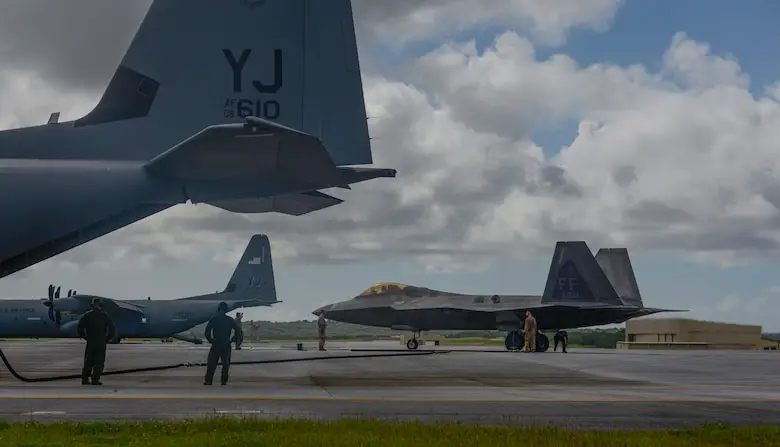A C-130J Super Hercules conducted a hot-pit refuel of a pair of F-22 Raptors Nov. 24 at Koror Palau International Airport using an Aerial Bulk Fuel Delivery System (ABFDS). ABFDS is an aerial, fuels-delivery system that enables aircraft to transport fuel rapidly to locations close to or behind enemy lines. This system is normally installed on C-130s but can be used on C-5 Galaxies and C-17 Globemaster IIIs. This mission was one of a series of operations associated with Westpac, a dynamic force employment of the 94th Expeditionary Fighter Squadron to the U.S. Indo-Pacific Command’s area of responsibility.

“Hot-pit refueling operations using ABFDS are relatively new,” said Chief Master Sgt. Steve McClure, Pacific Air Forces command fuels functional manager. The primary design of the ABFDS system is to refuel or to take bulk fuel to bladders in a contingency location. It has the capability to refuel aircraft and always has, but we’ve stepped that up with (agile combat employment). They’ve been phenomenal and worked a lot on getting us to where we’re at. If that location doesn’t have fuel support, we can generate a mission to fly in and off load fuel to the aircraft. There are more airfields than there is capability at those airfields,” McClure said.

The 374th Airlift Wing developed the checklist to use ABFDS to refuel other aircraft, and this is the second time C-130s from the 36th Airlift Squadron, 374th Airlift Wing, Yokota Air Base, Japan, have hot-pit refueled F-22 Raptors using ABFDS. The first time was during exercise Valiant Shield 20, a biennial, U.S.-only, joint field training exercise at Andersen Air Force Base, Guam, in September. The system consists of two, 3,000-gallon aerial bladder tanks, two pumping modules, a meter and hoses. It is also capable of delivering 600 gallons per minute with one pump or 1,200 gallons per minute with both pumps.

Should pilots find themselves running out of fuel and they cannot land at the airfield they departed from because it’s under attack or has battle damage, the pilots can divert to a different location knowing they can get refueled. Being able to get fuel to places in the USINDOPACOM theater of operations is important due to its size. The command’s area of responsibility is more than 100 million square miles, or roughly 52% of the Earth’s surface, stretching from the west coast of the United States, the west coast of India, and from the Arctic to the Antarctic, making this an important capability. ABFDS has been used in other USINDOPACOM exercises and used to rotate U-2 Dragon Ladies in and out of South Korea. The system was also loaded onto Royal Australian Air Force C-17s and used to refuel a C-130 during Arctic Ace 2018.













